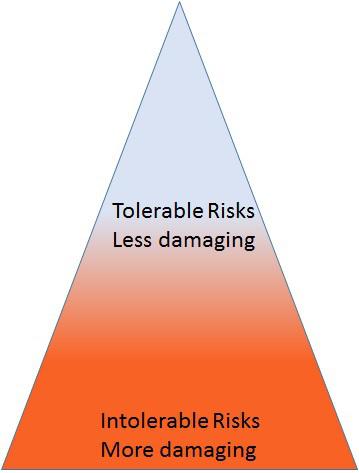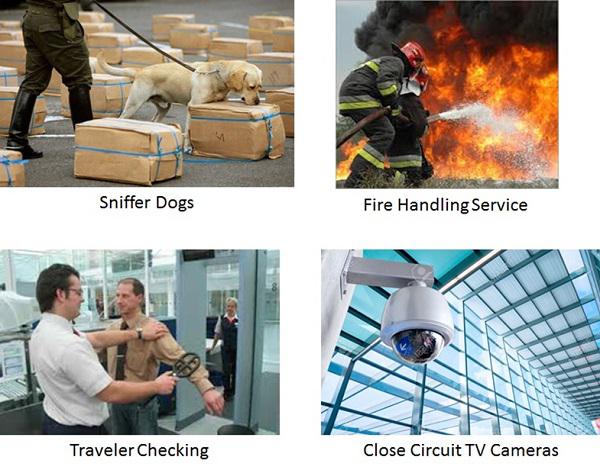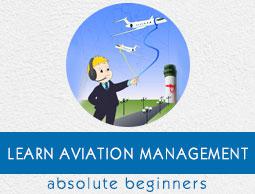Aviation - Safety Management
Aviation risks and threats are a part of the daily operations of the aviation industry. They can put passengers to face time delays, price hikes, uncertainty or even the loss of life. Though it uses radars, which spot intrusion into the controlled airspace and other navigational aids, the aircrafts face threats of losing its path. Today, though a large number of instruments aid aviation operations accurately in real time, aviation business is prone to hazards, risk, and threats.
Since numerous passengers travel by air frequently, there are objections related to risks, vulnerabilities, and threats.
Risks in Aviation
It is a potential loss or damage of property, information or lives (=assets) that can happen due to a threat. Literally, there is a risk if the assets, vulnerabilities, and threats are present together.
Common Aviation Risks
Aviation risks include operational, strategic, compliance, or financial risks that than put the assets into problem. There can be several types of risks for aircraft as well as airport −
- Bad weather conditions for a flying aircraft
- Aircraft about to run out of fuel while in flight
- A person in the aircraft or airport needs medical aid critically
- Failure of electrical, electronics, or mechanical component
- Pilot’s mistake
- Bird-strike at the time of aircraft movement
- An inexperienced employee or unknown person at the airport
- Unscreened passengers or their articles allowed to board the aircraft
- Repayment of loan
The risks can be seen as most forgivable to most intolerable.
Risk assessment is performed to uncover the loopholes in the systems and take corrective actions. Risk analysis is done to find out the particular cause of the accident or incident and reduce the likelihood of further risks.

Vulnerability in Aviation
Vulnerability is a weakness or a loophole in the security system. A threat can take undue advantage of a vulnerability to breach the security and destroy assets.
Common Aviation Vulnerabilities
The following can be the different vulnerabilities that the aviation industry undergoes −
- Access to airside area of the airport to non-traveler/non-staff people
- Poor screening methods for passengers and baggage
- Poor aircraft or airport maintenance
- Overcrowding near adjacent gates at the time of departure
- Poor security in handling information regarding flight plan
Threats in Aviation
A threat is a particular source of attack. Can someone forget the most notorious and perilous 9/11 attack where four airliners were hijacked to carry out a suicidal attack on World Trade Center and Pentagon. On December 24, 1999, Air India IC 814 with 178 passengers and 11 crew members was hijacked by terrorists and taken to Kandahar, under the then Taliban control. Today the terror methods have potentially increased with sophistication in destroying.
There are many such incidents when the aircrafts are hijacked by terrorists or extremists and this often leads to the loss of assets. These threats are mostly intentional. In some rare cases, mentally unstable people have been found to be the cause of such incidents.
Common Aviation Threats
The following can be the common aviation threats −
- Unattended or unclaimed baggage found at airport.
- A person carrying weapon without declaration.
- A person not cooperating with the security staff.
- A person carrying sharp objects with him.
- A call from an unknown person for destruction.
- A person with suspicious gestures and appearance.
Safety and Security in Aviation
The airport security systems and staff together work towards the safety of the airport, the aircraft, and also the safety of the passengers. To manage the airport as well as the aircraft security, the following measures are employed −
Aircraft and airport employees are trained on security and safety issues, as well as crisis handling procedures.
Aircrafts are equipped with emergency exit way and procedures for passengers.
Airport areas are monitored by Closed Circuit TV cameras.
A dedicated team of trained police force is employed for airport and aircraft safety.
The security staff takes the help of sniffer dogs to detect any unclaimed object lying around the airport.
The airports are equipped with fire-fighting alarm and fire-extinguishing systems.
Sensitive airside areas in airports, such as ramps and operational spaces, are restricted from the general public.
Every traveler who arrives at the airport needs to enter into the airport only from the Departure entry. The traveler can go in further only after showing a valid journey ticket, an identity proof, and a passport if required.
Non-passengers need to obtain a gate pass and face security checking to enter the secure area of the airport.
Traveler check-in baggage and handbags are strictly screened through X-ray machines.
Travelers are screened by metal detectors before they board. But they can be subjected to later screening if required.
Travelers are not permitted to enter the cockpit area of the aircraft.
The food joints at the airport use containers and glasses made of plastic instead of those made of glass as they can be used as weapons.

Dulles International Airport at Washington uses Fiber Optic Perimeter Intrusion Detection System that enables the airport security to locate and detect any intrusion on the airport perimeter, ensuring real-time, immediate intrusion notification. This further enables the security staff to carry out necessary security procedures.
A recent X-Ray technology is helping the airport safety and security staff to detect weapons and chemicals on passengers. This system has sensors to detect volatile compounds given off from explosives using gas chromatography.
Object Prohibited into Airport / Aircraft
Travelers are prohibited from carrying any personal stuff that can be harmful in the airport premises or in the aircraft. These objects are −
Personal Stuff − Razors, scissors, manicure kits, knives, ropes or strings
Liquids − Personal water-bottle, flammable or non-flammable liquids, fuels, gels
Explosives − Gas cans, fireworks or fire-extinguishers
Food Items − Jellies, soups, syrups, dips, salad dressings, vinegar, sauces, and alcohol
Tools − Crowbars, catapult, hammer, saw, drills and drill bits, screw-drivers, wrenches, pliers, metal or plastic wires
Sports Equipment − Hockey sticks, cricket bats, bows and arrows
Contingency Planning
The Air Navigation Service Provider (ANSP) needs to set up contingency strategies to handle future mishaps that may arise due to various risks and threats.
The contingency strategies are of two types −
- Alternate airspace strategies
- Alternate location strategies
Contingency Planning involves −
Finding out if there is an already existing plan to manage the consequences of the incidents or accidents.
Inventory of the units/services/functions of an Air Navigation Service Provider (ANSP).
Identifying realistic events which increase the likelihood of the mishaps and lead to the loss of assets.
Developing or changing contingency measures that meet safety and security requirements.
Developing a plan for Contingency Assessment to ensure that contingency requirements are met.
Developing plan and procedures to resume the normal operations.
Birds, Wildlife, and Snow Control
Collision with birds is one of the major challenges for aircraft safety. Aircrafts can sometimes damage themselves after colliding with birds. To avoid such mishaps, the airports need to install Airport Bird Control System, which is specifically created for repelling birds and other wandering animals away from airports and runways.
Some airports use Bird Aversion Liquid or Gas, which upon spraying creates an invisible barrier between birds and aircraft. This spray irritates birds' sensory system, which is harmless for their life but keeps them from flying near airport.
Some electronic bird repellent systems also have high-output amplifiers with multiple speakers installed in tower design. These systems are weatherproof and are capable of repelling birds up to 30 acres with a sound output around 125 DB.

It is not just the combination of a bird and an aircraft flying into each other that is dreadful. An animal on the runway also can cause a great hazard as flipping an aircraft while taking off or landing. There are chances of wild animals entering the runway if it is not properly secured. To deter animals’ entry, the airports are surrounded with partially buried fencing.





